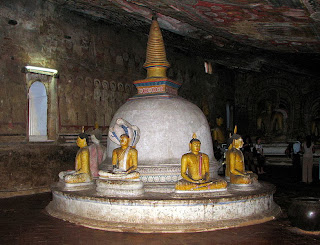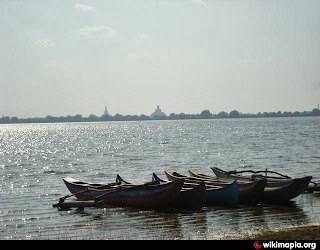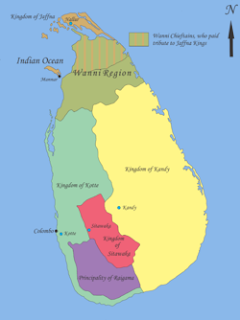Kuveni
Vijaya's arrival in Sri Lanka is said to have coincided with the passing away of the Buddha. Indeed the very first 'person' that Vijaya supposedly encounters on the island is the 'Lord of the Gods', Lord Vishnu, who is charged by the ailing Buddha with looking after Vijaya and his descendants.
The second encounter is far less auspicious - a Yakkinni, or demoness, who 'appeared in the form of a dog'. Vijaya's men, surmising that 'Only where there is a village are dogs to be found', followed the creature, only to come upon the Queen of the demons, Kuveni (also known as Kuvanna). Though the protection of Vishnu prevented Kuveni from devouring the hapless man, it did not prevent her from hurling him - and all of Vijaya's other companions - into a chasm.
Vijaya eventually comes upon Kuveni and threatens her with death unless she releases his men. When this is done, Kuveni supplies them with food and clothing, and, 'assuming the lovely form of a sixteen year old maiden' seduces Vijaya. Then, in a complete reversal of her allegiances, she states that she 'will bestow Kingship on my Lord (Vijaya)' and thus 'all the Yakkhas must be slain, for (else) the Yakkhas will slay me, for it was through me that men have taken up their dwelling (in Lanka)'. This Vijaya goes on to do, vanquishing the demons and driving them from the island, all the time with Kuveni at his side.
Though Kuveni bears him two children, a son and a daughter, Vijaya eventually rejects her with the words 'Go now, dear one, leaving the two children behind; men are ever in fear of superhuman beings'. Despite begging Vijaya not to send her away, a broken-hearted Kuveni eventually leaves the palace, taking the two children despite being ordered not to. Arriving in one of the few surviving Yakka cities she is killed by her own people for her betrayal. One of her uncles takes pity on her children and tells them to flee before they, too, are killed. They eventually flee to Malaya rata where they settle and become the ancestors of the Pulindas. And alternative tale is that Kuveni flung herself from Yakdessa Gala, imploring the Gods to curse Vijaya for his cruelty - which they do by preventing any of Vijaya's children from ever sitting on the throne of Rajarata. 'Vijaya's curse' is held by some to still hold sway over Sri Lanka's troubled politics.
The Kuveni-Vijaya story evokes some similarities with the encounter of Odysseus with Circe. Circe is also an enchantress and a witch. The Kuveni myth is also remarkable for being so violent and tragic. Both the demon Queen and Vijaya are portrayed as being deeply treacherous and unfeeling - the former in betraying her entire people, the latter in betraying her in turn so callously. Indeed Vijaya's reason for rejecting Kuveni is his desire for a 'a maiden of a noble house' to be consecrated Queen with him. This desire could have had a political aspect - in marrying a princess of an established noble house he would essentially have established himself as a legitimate monarch in his own right, on a par with the other rulers of the subcontinent's kingdoms.
Kuveni, on the other hand, is regarded as a descendant of the demons of the Ramayana and of Ravana, who also dwelled in Lanka. A common folk tale was that her children did not, in fact, flee to Malaysia, but instead remained in Sri Lanka's jungles and became the Veddas - Sri Lanka's aboriginal population. This may indeed be the explanation for Kuveni and her people, as early Indian settlers would almost certainly have come into contact and conflict with indigenous Sri Lankans. The Yakkas are referred to occasionally as 'invisible', and indeed would have appeared so to the newcomers unused to Sri Lanka's jungles, through which the Veddas even today can move in near-silence and with barely a trace.
The Dipavamsa, on which the Mahavamsa is based, makes no mention of Kuveni whatsoever.
History of Sri Lanka
The proud History of Sri Lanka. This is the official blog of lankaurumaya.webs.com
Sunday, September 7, 2014
Anuradhapura Kingdom
Anuradhapura Kingdom
 In the early ages of the Anuradhapura Kingdom the economy was based on farming and they made their early settlements mainly near the rivers of the east, north central, and north east areas which had the water necessary for farming the whole year round. The king was the ruler of country and responsible for the law, the army, and being the protector of faith. Devanampiya Tissa (250–210 BC) was Sinhalese was friends with the King of the Maurya clan. His links with Emperor Asoka led to the introduction of Buddhism by Mahinda (son of Asoka) around 247 BC. Sangamitta (sister of Mahinda) brought a Bodhi sapling via Jambukola (Sambiliturei). This king's reign was crucial to Theravada Buddhism and for Sri Lanka.
In the early ages of the Anuradhapura Kingdom the economy was based on farming and they made their early settlements mainly near the rivers of the east, north central, and north east areas which had the water necessary for farming the whole year round. The king was the ruler of country and responsible for the law, the army, and being the protector of faith. Devanampiya Tissa (250–210 BC) was Sinhalese was friends with the King of the Maurya clan. His links with Emperor Asoka led to the introduction of Buddhism by Mahinda (son of Asoka) around 247 BC. Sangamitta (sister of Mahinda) brought a Bodhi sapling via Jambukola (Sambiliturei). This king's reign was crucial to Theravada Buddhism and for Sri Lanka.
Elara (205–161 BC) was a Tamil King who ruled "Pihiti Rata" (Sri Lanka north of the mahaweli) after killing King Asela. During Elara's time Kelani Tissa was a sub-king of Maya Rata (in the south-west) and Kavan Tissa was a regional sub-king of Ruhuna (in the south-east). Kavan Tissa built Tissa Maha Vihara, Dighavapi Tank and many shrines in Seruvila. Dutugemunu (161–137 BC), the eldest son of King Kavan Tissa, at 25 years of age defeated the South Indian Tamil invader Elara (over 64 years of age) in single combat, described in the Mahavamsa. The Ruwanwelisaya, built by Dutugemunu, is a dagaba of pyramid-like proportions and was considered an engineering marvel.
Pulahatta (or Pulahatha), the first of The Five Dravidians, was deposed by Bahiya. He in turn was deposed by Panaya Mara who was deposed by Pilaya Mara, murdered by Dathika in 88 BC. Mara was deposed by Valagambahu I (89–77 BC) which ended Tamil rule. The Mahavihara Theravada Abhayagiri ("pro-Mahayana") doctrinal disputes arose at this time. The Tripitaka was written in Pali at Aluvihara, Matale. Chora Naga (63–51 BC), a Mahanagan, was poisoned by his consort Anula who became queen. Queen Anula (48–44 BC), the widow of Chora Naga and of Kuda Tissa, was the first Queen of Lanka. She had many lovers who were poisoned by her and was killed by Kuttakanna Tissa. Vasabha (67–111 AD), named on the Vallipuram gold plate, fortified Anuradhapura and built eleven tanks as well as pronouncing many edicts. Gajabahu I (114–136) invaded the Chola kingdom and brought back captives as well as recovering the relic of the tooth of the Buddha.
There was a huge Roman trade with the ancient Tamil country (present day Southern India) and Sri Lanka, establishing trading settlements which remained long after the fall of the Western Roman empire.
During the reign of Mahasena (274–301) the Theravada (Maha Vihara) was persecuted and the Mahayanan branch of Buddhism surfaced. Later the King returned to the Maha Vihara. Pandu (429) was the first of seven Pandiyan rulers, ending with Pithya in 455. Dhatusena (459–477) "Kalaweva" and his son Kashyapa (477–495), built the famous sigiriya rock palace where some 700 rock graffiti give a glimpse of ancient Sinhala.
 In the early ages of the Anuradhapura Kingdom the economy was based on farming and they made their early settlements mainly near the rivers of the east, north central, and north east areas which had the water necessary for farming the whole year round. The king was the ruler of country and responsible for the law, the army, and being the protector of faith. Devanampiya Tissa (250–210 BC) was Sinhalese was friends with the King of the Maurya clan. His links with Emperor Asoka led to the introduction of Buddhism by Mahinda (son of Asoka) around 247 BC. Sangamitta (sister of Mahinda) brought a Bodhi sapling via Jambukola (Sambiliturei). This king's reign was crucial to Theravada Buddhism and for Sri Lanka.
In the early ages of the Anuradhapura Kingdom the economy was based on farming and they made their early settlements mainly near the rivers of the east, north central, and north east areas which had the water necessary for farming the whole year round. The king was the ruler of country and responsible for the law, the army, and being the protector of faith. Devanampiya Tissa (250–210 BC) was Sinhalese was friends with the King of the Maurya clan. His links with Emperor Asoka led to the introduction of Buddhism by Mahinda (son of Asoka) around 247 BC. Sangamitta (sister of Mahinda) brought a Bodhi sapling via Jambukola (Sambiliturei). This king's reign was crucial to Theravada Buddhism and for Sri Lanka.Elara (205–161 BC) was a Tamil King who ruled "Pihiti Rata" (Sri Lanka north of the mahaweli) after killing King Asela. During Elara's time Kelani Tissa was a sub-king of Maya Rata (in the south-west) and Kavan Tissa was a regional sub-king of Ruhuna (in the south-east). Kavan Tissa built Tissa Maha Vihara, Dighavapi Tank and many shrines in Seruvila. Dutugemunu (161–137 BC), the eldest son of King Kavan Tissa, at 25 years of age defeated the South Indian Tamil invader Elara (over 64 years of age) in single combat, described in the Mahavamsa. The Ruwanwelisaya, built by Dutugemunu, is a dagaba of pyramid-like proportions and was considered an engineering marvel.
Pulahatta (or Pulahatha), the first of The Five Dravidians, was deposed by Bahiya. He in turn was deposed by Panaya Mara who was deposed by Pilaya Mara, murdered by Dathika in 88 BC. Mara was deposed by Valagambahu I (89–77 BC) which ended Tamil rule. The Mahavihara Theravada Abhayagiri ("pro-Mahayana") doctrinal disputes arose at this time. The Tripitaka was written in Pali at Aluvihara, Matale. Chora Naga (63–51 BC), a Mahanagan, was poisoned by his consort Anula who became queen. Queen Anula (48–44 BC), the widow of Chora Naga and of Kuda Tissa, was the first Queen of Lanka. She had many lovers who were poisoned by her and was killed by Kuttakanna Tissa. Vasabha (67–111 AD), named on the Vallipuram gold plate, fortified Anuradhapura and built eleven tanks as well as pronouncing many edicts. Gajabahu I (114–136) invaded the Chola kingdom and brought back captives as well as recovering the relic of the tooth of the Buddha.
There was a huge Roman trade with the ancient Tamil country (present day Southern India) and Sri Lanka, establishing trading settlements which remained long after the fall of the Western Roman empire.
During the reign of Mahasena (274–301) the Theravada (Maha Vihara) was persecuted and the Mahayanan branch of Buddhism surfaced. Later the King returned to the Maha Vihara. Pandu (429) was the first of seven Pandiyan rulers, ending with Pithya in 455. Dhatusena (459–477) "Kalaweva" and his son Kashyapa (477–495), built the famous sigiriya rock palace where some 700 rock graffiti give a glimpse of ancient Sinhala.
Sunday, December 8, 2013
Ancient Construction in Sri Lanka
Ancient Cave Temples in Sri Lanka
 In Sri Lanka there are lots of cave temples like Dambulla temple that situates in Matale District, Central Province. And it has lots of complex artworks that done by ancient sinhalese. It is smoothly done by hand. And also some cave temple are len vihara that buddhist monks do their meditations and special occasions in their. Some cave temples are situated in forests so that the buddhist monks can peacefully do their meditation without any interruption. Some cave temples stands today also. Like.....
In Sri Lanka there are lots of cave temples like Dambulla temple that situates in Matale District, Central Province. And it has lots of complex artworks that done by ancient sinhalese. It is smoothly done by hand. And also some cave temple are len vihara that buddhist monks do their meditations and special occasions in their. Some cave temples are situated in forests so that the buddhist monks can peacefully do their meditation without any interruption. Some cave temples stands today also. Like.....- Vessagiri
- DAmbulla Rock Temple
- Pilikuththuwa Raja Maha Viharaya
- Aluvihara Rock cave Temple
- Dambulla Temple
- Bogoda Cave Temple
Irrigation Works
 In ancient Sri Lanka agriculture is the main part of the society. And water is needed to the agriculture. And ancient Sinhalese find an answer to it. And this is how the irrigation work began in Sri Lanka. And we can see lots of irrigation works in Anuradhapura and Polonnaruwa kingdoms. Because most of the kings ruled these kingdoms gave a speciality to agriculture. And it can prove by King Parackramabahu's words "Let not even a drop of rain water go to the sea.".
In ancient Sri Lanka agriculture is the main part of the society. And water is needed to the agriculture. And ancient Sinhalese find an answer to it. And this is how the irrigation work began in Sri Lanka. And we can see lots of irrigation works in Anuradhapura and Polonnaruwa kingdoms. Because most of the kings ruled these kingdoms gave a speciality to agriculture. And it can prove by King Parackramabahu's words "Let not even a drop of rain water go to the sea.".
And also there are lots of major tanks that holds the rainwater to use in the dry season. These irrigations works saved lot of people lives because it holds lots of water that can use for many months.
Major Water Tanks in Sri Lanka
- Tisa wawe
- Parakrama Samudraya
- Kala wawe
- Nuwara wawe
- Yoda wawe
- Kantale wawe
- Hurulu wawe
- Nacchiduwa wawe
- Abayawapi Tank
- Mineriya wawe
Saturday, November 16, 2013
Anuradhapura Kingdom
Anuradhapura Kingdom
(අනුරාධපුර රාජධානිය)
The First Kingdom in Sri Lankan Ancient History
The kingdom was founded by King Bandukhabhaya in 377 BC. This kingdom is main part in the Sri Lankan History. Because this kingdom plays the main role in the Sri Lankans ancient history. Like arrival of the Buddhism to Sri Lanka.
The History of this Kingdom
In 553 BC a person called Vijaya came to Sri Lanka, because he caused trouble to the people live in ancient India. Actually he is the son of king Sinhabahu who ruled the India in 553 BC. Vijaya was came with 700 men. And he placed them all around the Rajarata area (රජරට) (now it is called the North Central Province). And eventually got the ruler of that area. And then king Pandukhabaya came and officially established the kingdom and named it as Rajarata Rajadhaniya (රජරට රාජධානිය).
Then he developed the kingdom with a new ideas like lakes. According to Mahawansaya (මහාවංශය) he was the first king who build the first lake in Sri Lanka named Basawakkulama (බසවක්කුලම). And it was great idea because in the dry season the lake can store water and protect the people from hunger.
Arrival of the Buddhism
In king Dewanampiyathissa (දේවානම්පියතිස්ස) time the ruler of the India (King Asoka) is a best friend of the king Dewanampiyathissa. So because the friendship Sri Lanka got the Buddhism and the Sri Maha Bodiya (ශ්රී මහා බෝධිය) with new technology like Architecture. And the Buddhism famous all around the Sri Lanka because the king also got Buddhist in this event.
Sunday, November 10, 2013
Kandy Kingdom
Kandy Kingdom
The last kingdom of the Sri Lankan History

Royal Flag of the Kingdom
Sri Lanka has several kingdoms in the past and the last kingdom is Kandy kingdom. It is also called the Udarata Rajadhaniya in Sinhala. It is situated in the central province of Sri Lanka. And it has the great Lord Buddha's tooth relic. From 1473 to 1815 Kandy is the capital city of Sri Lanka. And the kingdom was controlled by a King that got the crown from generation to generation. The main religion is the buddhism. But also there are Tamils and Muslims to.
Official named that has give to Kandy Kingdom
- Kanda uda pasrata
- Senkadagala pura
- Kanda Udarata
- Mahanuwara Rajadhaniya
- Sri Wardhanapura
The last kingdom of the Sri Lankan History
 |
| Royal Flag of the Kingdom |
Sri Lanka has several kingdoms in the past and the last kingdom is Kandy kingdom. It is also called the Udarata Rajadhaniya in Sinhala. It is situated in the central province of Sri Lanka. And it has the great Lord Buddha's tooth relic. From 1473 to 1815 Kandy is the capital city of Sri Lanka. And the kingdom was controlled by a King that got the crown from generation to generation. The main religion is the buddhism. But also there are Tamils and Muslims to.
Official named that has give to Kandy Kingdom
- Kanda uda pasrata
- Senkadagala pura
- Kanda Udarata
- Mahanuwara Rajadhaniya
- Sri Wardhanapura
Kings who controlled the Kandy Kingdom
- Senasammatha WickramaBahu (1473-1511)
- Jayaweera Asthana (1511-1551)
- Karaliyadde Bandara (1551-1581)
- Dona Catherina ( 1581-1581)
- Rajasingha (1581-1593)
- Vimaladarmasuriya (1590-1604)
- Rajasingha || (1635-1687)
- Vimaladaramasuriya || (1687-1707)
- Vira Narendrasingha (1707-1739)
- Vijaya Rajasingha (1739-1747)
- Kirthi Sri Rajasingha (1747-1782)
- Rajadhi Rajasingha (1782-1798)
- Sri Vicrama Rajasingha (1798-1815)
Geographical and climate data about Kandy Kingdom
The kingdom is surrounded by lots of mountains and maha weli river. So the Kandy got some protection form natural disasters and form terrorists. The climate is great for living and for the agricultural purposes.
Subscribe to:
Comments (Atom)





